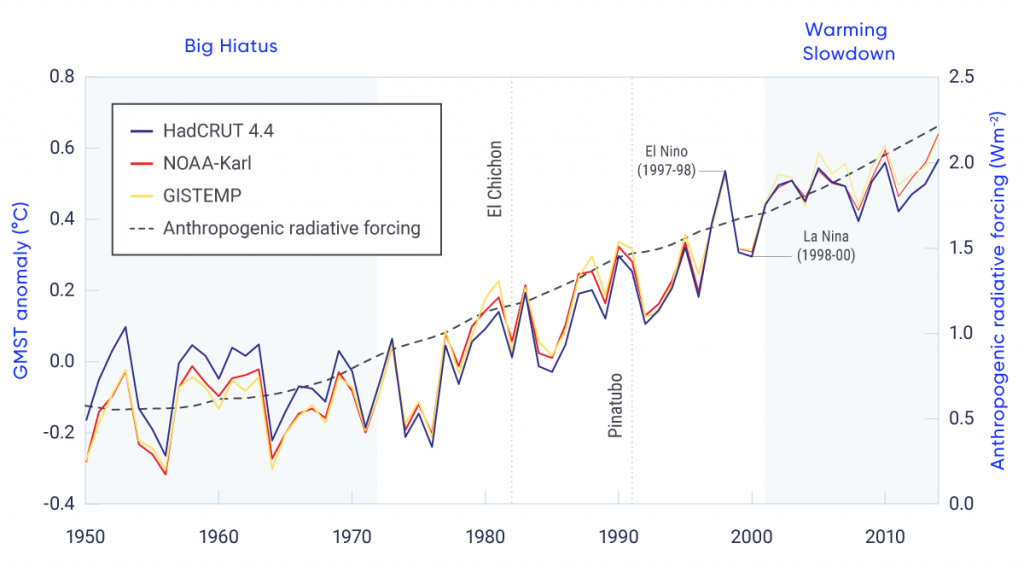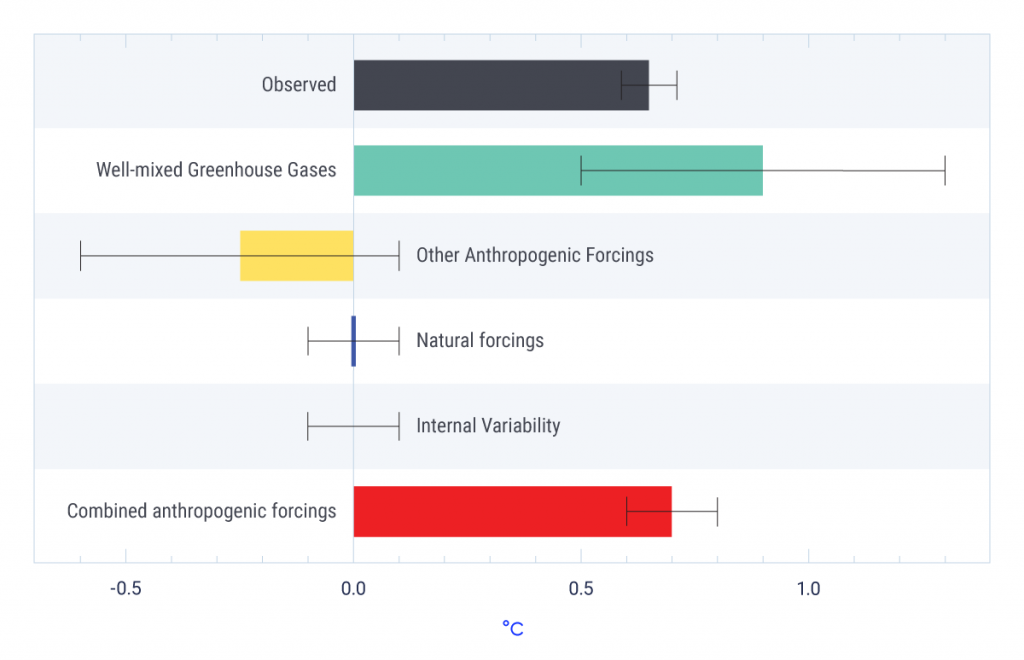Even when a strong anthropogenic forcing drives climate change (see Section 2.3.2), signals of climate change may be difficult to detect against a backdrop of a climate system that is naturally chaotic – “noisy”. This chaotic behaviour is due to internal climate variability and natural external forcings, which can be large over short periods (for example, forcing by volcanic eruptions). Internal climate variability, such as El Niño–Southern Oscillation (ENSO) (see Box 2.5), is variability that arises within the climate system, independent of variations in external forcing.
Global mean surface temperature (GMST), as calculated by a linear trend, has increased significantly since the 1880s, especially since the 1950s (see Section 2.2.1). However, the changes in GMST have been far from uniform, with substantial variability among years, decades, and periods spanning several decades. These short-term fluctuations are superimposed on an underlying externally forced trend (see Figure 2.9) (Morice et al., 2012; Karl et al., 2015; Hansen et al., 2010).
To analyze the causes of the short-term fluctuations in GMST, we first need to be confident that the observed variability is real and not an artifact, an error introduced by the way the data were collected or analyzed. Long-term GMST time series have been produced by a small number of scientific teams using data collected from around the world. Values are reported as an anomaly: a departure from the average over a reference period (1961–1990 for Figure 2.9). Differences among the estimates are due mainly to differing choices made in processing the underlying raw observations. For example, one estimate (HadCRUT4.4) is an average for only those grid cells where observations exist, whereas the other estimates (NOAA-Karl and GISTEMP) use infilling; if observations are missing for certain locations, they are estimated based on values for neighbouring locations. These estimates of GMST, and others, are routinely updated as errors are identified and adjusted (see Box 4.1). Correcting and updating long-term datasets with new observations as these become available is imperative for tracking global change from year-to-year, decade-to-decade, and century-to-century.
Some of the ups and downs over time shown in Figure 2.9 are associated with the ENSO, the fairly periodic internal variation in sea surface temperatures over the tropical eastern Pacific Ocean, affecting much of the tropics, subtropics, and some areas outside the tropics, including Canada (Box 2.6). The warming phase is known as El Niño and the cooling phase as La Niña. ENSO events can be powerful enough to be recorded as significant signals in GMST. The 1997/1998 El Niño was regarded as one of the most powerful El Niño events in recorded history, resulting in widespread droughts, flooding, and other natural disasters across the globe (Trenberth, 2002). It terminated abruptly in mid-1998 and was followed by a moderate-to-strong La Niña, which lasted until the end of 2000 (Shabbar and Yu, 2009).
Some other ups and downs shown in Figure 2.9 are associated with natural external forcing agents, such as large volcanic eruptions. The 1991 eruption of Mount Pinatubo, in the Philippines, was the second largest terrestrial eruption of the 20th century. It ejected a massive amount of particulate matter into the stratosphere and produced a global layer of sulphuric acid haze. GMST dropped significantly in 1991–1993 (McCormick et al., 1995). Similarly, the 1982 eruption of El Chichón, the largest volcanic eruption in modern Mexican history, ejected a large amount of sulphate aerosols into the stratosphere (Robock and Matson, 1983). The cooling impact of the of El Chichón eruption on GMST from 1982 to 1984 was partly offset by global warming associated with a very strong El Niño event during this time (Robock, 2013).
Naturally occurring variations in GMST, whether internally generated or externally forced, should be viewed in the context of global mean radiative forcing caused by human activities (Fyfe et al., 2016). The combined radiative forcing from human activities has increased over time (see Figure 2.9) (Meinshausen et al., 2011). The periods in Figure 2.9 labelled “big hiatus” and “warming slowdown” correspond to times when the dominant mode of internal decadal variability in the Pacific — the Interdecadal Pacific Oscillation (IPO) — was in its negative (cold) phase. In addition, during the “big hiatus” period, radiative forcing increased relatively slowly, owing to cooling contributions from increasing tropospheric aerosols, as well as stratospheric aerosols from the Mount Agung eruption in 1963 (e.g., Fyfe et al. 2016). In the intervening period, the IPO was in its positive (warm) phase. A given phase, warm or cold, of the IPO typically lasts from 20 to 30 years, much longer than the timescale associated with ENSO. Recent computer models (Meehl et al., 2013; Kosaka and Xie, 2013; England et al., 2014) and studies based on observations (Steinman et al., 2015; Dai et al., 2015) indicate that the IPO plays an important role in changes in GMST over time.
Finally, the “warming slowdown” — a slowdown in the rate of increase of GMST observed over the early 2000s — has been much debated (Karl et al., 2015; Lewandowsky et al., 2015; Rajaratnam et al., 2015). Observations indicate that the rate of global mean surface warming from 2001 to 2015 was significantly less than the rate over the previous 30 years (Fyfe et al., 2016). It is now understood that both internal variability and external forcing contributed to the warming slowdown (Flato et al., 2013; Fyfe et al., 2016; Santer et al., 2017). The contribution from external forcing has been ascribed to: 1) a succession of moderate volcanic eruptions in the early 21st-century (Solomon et al., 2011; Vernier, 2011; Fyfe et al., 2013; Santer et al., 2014; Ridley et al., 2014; Santer et al., 2015); 2) a long and anomalously low solar minimum during the last solar cycle (Kopp and Lean, 2011; Schmidt et al., 2014); 3) increased atmospheric burdens of sulphate aerosols from human activity (Smith et al., 2016); and 4) a decrease in stratospheric water vapour (Solomon et al., 2010). In the last several years, GMST has warmed substantially (e.g., Hu and Fedorov, 2017), with an exceptionally strong ENSO in 2015/2016, suggesting that the warming slowdown is now over.
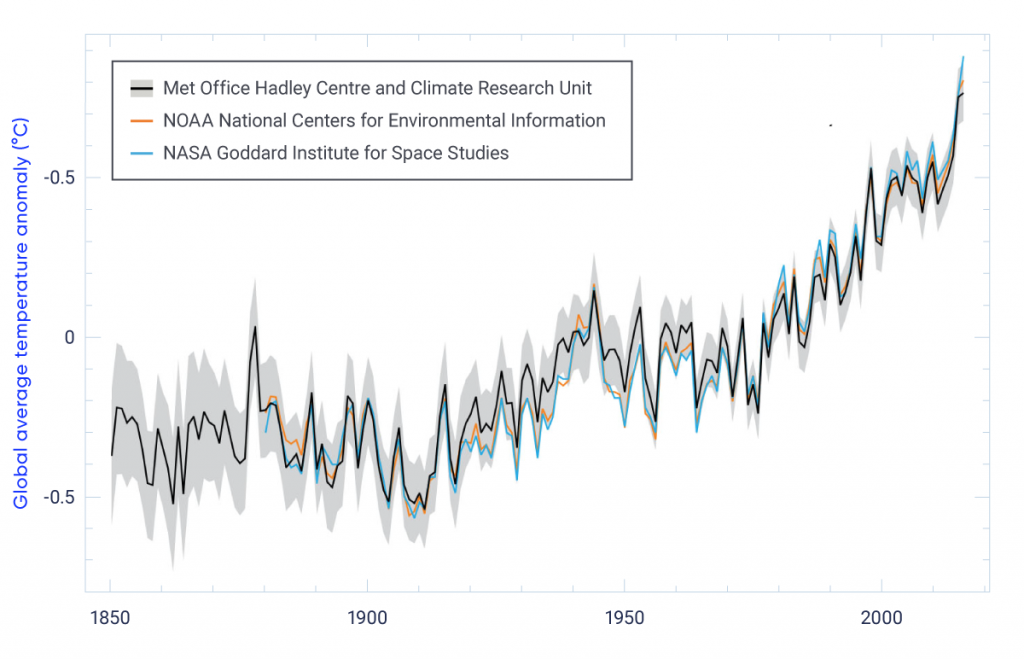
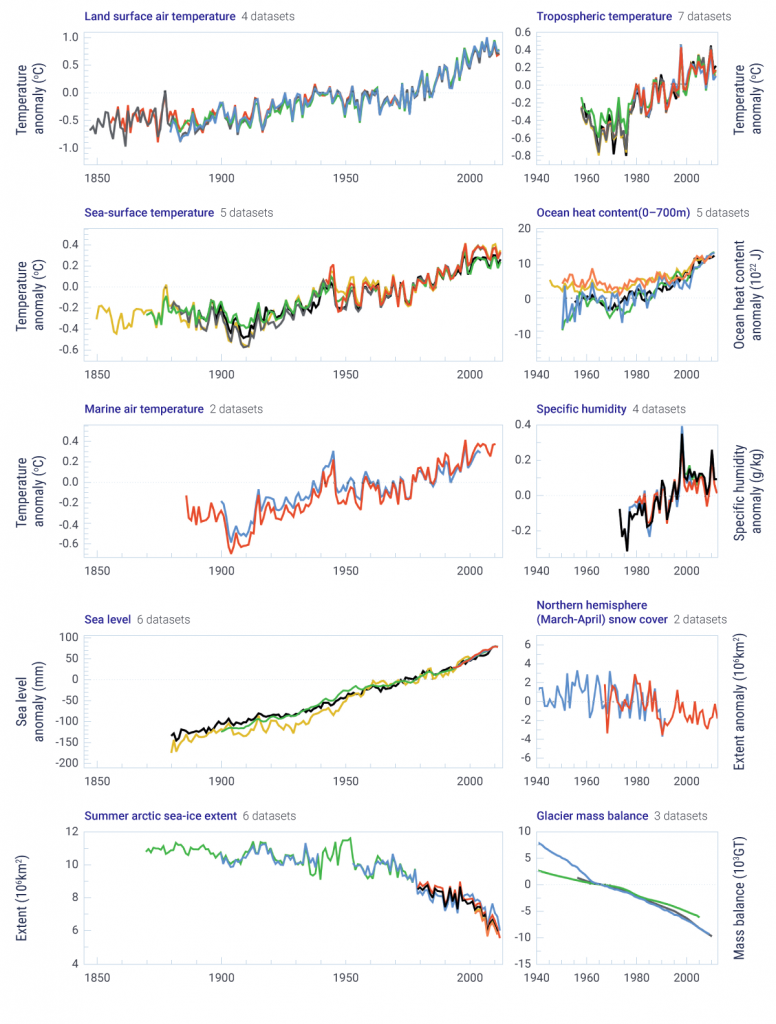
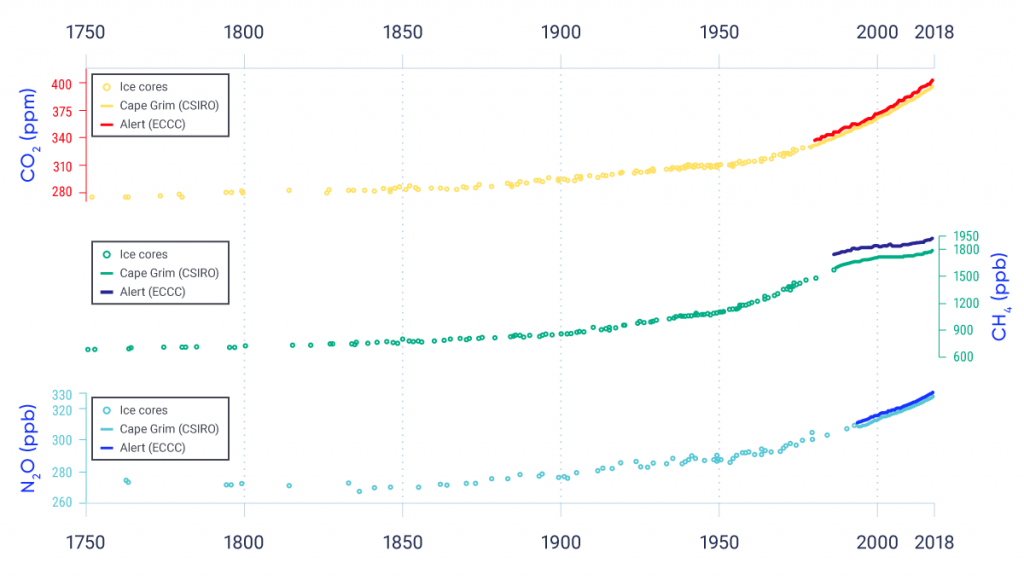
![A horizontal bar chart showing radiative forcing (and effective radiative forcing) for different forcing agents between 1750 and 2011, along with assessed uncertainties. Radiative forcing is the net change in the energy balance of the Earth system due to an external perturbation, expressed in units of watts per square metre (W/m2). The central axis of the bar chart is 0 W/m2. Bars to the right have positive radiative forcing values (warming effects), whereas bars to the left have negative radiative forcing values (cooling effects). The total anthropogenic forcing is positive, with a best estimate of 2.3 W/m2. The chart shows that the largest contributions to this anthropogenic radiative forcing are positive forcing contributions from carbon dioxide, other well-mixed greenhouse gases, and tropospheric ozone; these are offset by negative forcing contributions from aerosols. The natural forcing from changes in solar irradiance is positive but at least 10 times smaller than the combined anthropogenic forcing. Forçage radiatif (FR; le changement net dans le bilan énergétique du système terrestre en raison d’une perturbation de l’extérieur), selon le changement de concentrations des agents forçant, entre 1750 et 2011, exprimées en watts par mètre carré (W/m2). Les barres hachurées représentent le forçage radiatif (FR), les barres solides représentent le forçage radiatif effectif (FRE), le FR, une fois que l’on tient compte des ajustements rapides des températures atmosphériques, de la vapeur d’eau et des nuages dans la perturbation initiale. Les incertitudes (plage d’incertitude de 5 % à 95 %) sont données pour le FRE (lignes horizontales solides [moustaches]) et le FR (moustaches pointillées). Le nombre total de forçages anthropiques est la somme des contributions du forçage anthropique. Voir la description à la section 2.2.](https://dev.changingclimate.ca/site/assets/uploads/sites/2/2019/01/Figure-2.8-1-1024x652.png)
